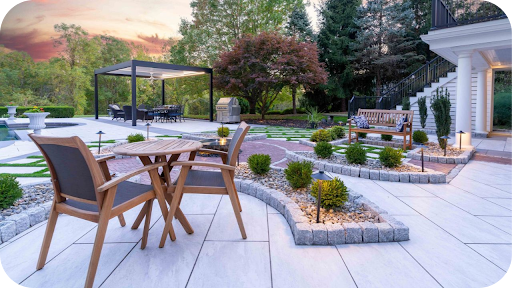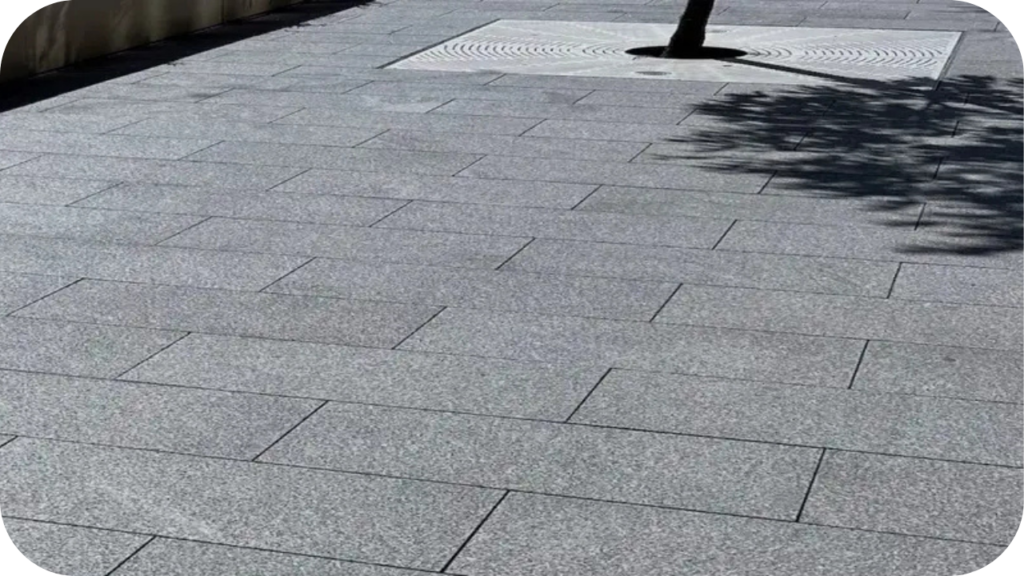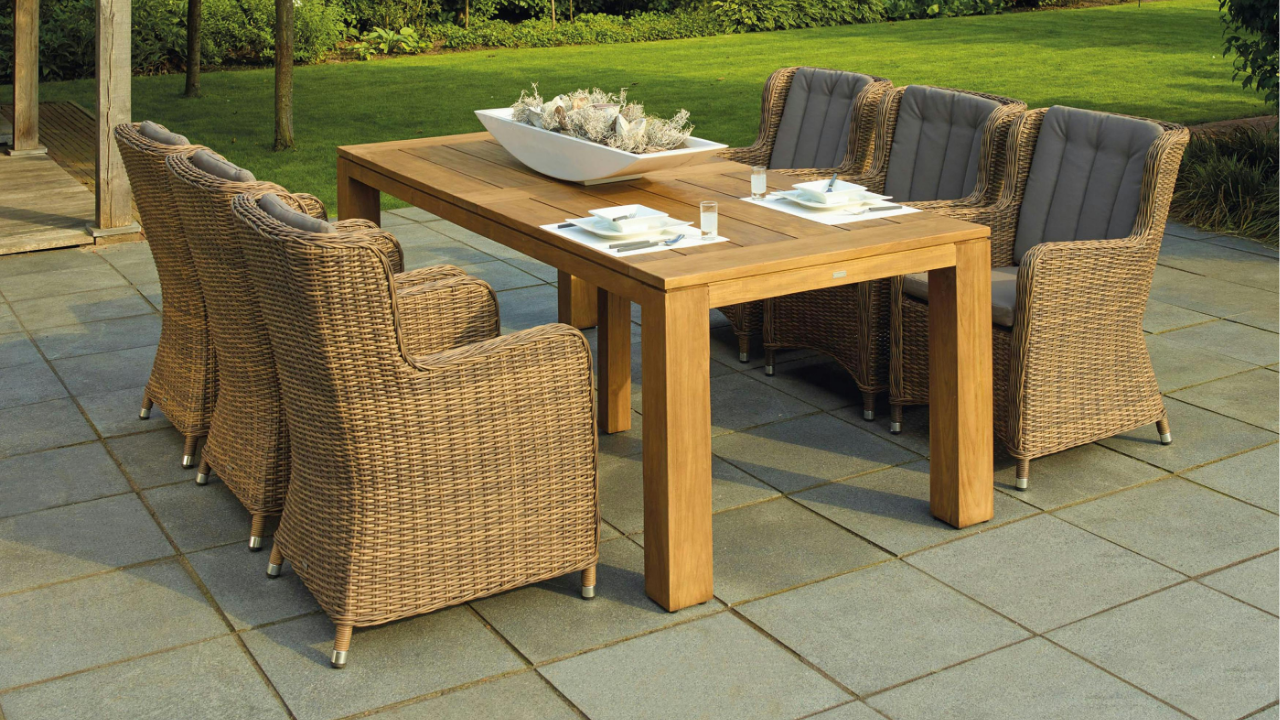
Heavy rain can quickly turn a beautiful outdoor space into a frustrating pool of standing water. Many homes face similar drainage issues, especially in high-traffic areas where water has nowhere to go.
Homeowners are now turning to smarter solutions that manage water naturally while still keeping the landscape attractive. Permeable paving offers a long-lasting way to improve drainage without compromising style or durability.
This article explains the best natural stone options for permeable paving, why they work well and how to choose the right pavers for effective drainage across your outdoor areas.
What Are the Best Permeable Pavers for Drainage?
The best permeable pavers for drainage are natural stones with strong durability and natural porosity. Granite, bluestone, porphyry, limestone and travertine allow water to pass through joint gaps while remaining stable under foot traffic. These stones provide reliable drainage, reduce pooling and improve long-term performance in outdoor landscapes.
Best Natural Stone Types for Permeable Paving
Choosing the right natural stone can significantly improve the drainage performance of your permeable paving system in outdoor areas exposed to regular weather changes. Here’s how.
1. Granite Pavers
Granite provides strong surface stability and a textured feel that helps water move through the joints with ease. For those wanting durable options, varieties such as Charcoal Granite or Grey Granite offer reliable performance while maintaining a modern, structured appearance in outdoor areas.
2. Bluestone Pavers
Bluestone contains gentle natural porosity that allows moisture to settle into the ground instead of sitting on top. Its textured finishes improve grip and make it practical in wet conditions. Homeowners often choose examples like Honed Bluestone or Flamed Bluestone when creating high-performing pathways and courtyards.
3. Porphyry Pavers
Porphyry features naturally split surfaces and irregular edges that create organic channels for water to flow through. This quality supports stability even on uneven terrain. Varieties like Crazy Porphyry or Filetti Porphyry are often selected when a visually distinctive finish is desired alongside dependable drainage.
4. Limestone Pavers
Limestone offers subtle porosity and stays comfortable underfoot, making it a strong choice for entertainment spaces and garden walkways. Its soft textures help guide water through the joints without disrupting the design. Options such as Loch Limestone or Brooklyn Limestone are commonly used as practical examples for permeable layouts.
5. Travertine Pavers
Travertine contains natural pits that improve water absorption and reduce surface moisture. This breathable quality suits pool surrounds and pathways that remain exposed to sunlight. For aesthetic variety, examples like Silver Travertine or Ivory Travertine deliver a refined look while supporting effective drainage.
Key Benefits of Permeable Pavers for Drainage

Permeable paving plays a major role in creating safer and more efficient outdoor spaces by managing water naturally across your landscape. Here’s why.
1. Reduces Surface Water Run Off
Permeable pavers allow rainwater to pass through the gaps between each stone, reducing the amount of water flowing across hard surfaces. This helps direct water into the ground where it can drain safely rather than collecting on paths and driveways.
2. Minimises Pooling and Flooding
Outdoor areas often flood when water has nowhere to move. Permeable pavers solve this issue by encouraging steady infiltration through the joints. The system lowers the risk of puddles forming after heavy rain and keeps high-traffic spaces more usable.
3. Supports Groundwater Recharge
Natural infiltration encourages water to return to the soil instead of overwhelming stormwater systems. This helps maintain healthier groundwater levels, especially during dry periods. It also supports more sustainable water movement within your property.
4. Prevents Erosion on Sloped Sites
Steeper areas are more prone to erosion when water moves quickly across the surface. Permeable paving slows this movement, reducing soil displacement and protecting the structural stability of gardens, pathways and retaining wall zones.
5. Enhances Landscaping Sustainability
Permeable stone surfaces create a more environmentally friendly landscape by reducing pressure on drains and supporting natural water cycles. This makes them ideal for homeowners looking for greener, longer-lasting outdoor solutions.
Key Factors When Choosing Permeable Pavers
Choosing the right paving material depends on how well each stone handles moisture, supports drainage and maintains stable performance across outdoor areas. This is what matters most.
1. Stone Porosity and Water Absorption
Porosity influences how well water moves through a paved surface. Stones with natural absorbency guide moisture into the ground, reduce surface pooling and support a more efficient drainage pattern across landscaped areas that experience regular rainfall.
2. Surface Texture and Grip Performance
Texture affects how dependable the surface feels underfoot, especially when moisture is present. Stones with gentle grain patterns support smoother water movement between the joints while maintaining confident footing across pathways, courtyards and outdoor areas frequently exposed to rain.
3. Thickness and Structural Strength
Paver thickness determines how well the surface handles pressure. Driveways require sturdier stones that support heavier loads, while slimmer profiles suit lighter foot traffic areas where stability and long-term performance remain essential.
4. Joint Width, Grouting and Installation Base
Joint spacing directly affects water flow through the paved surface. Wider joints filled with crushed rock improve infiltration, and a well-prepared open-graded base keeps the system stable while supporting long-term permeability.
5. Colour and Heat Performance
Stone colour influences surface temperature during warmer months. Lighter tones stay cooler under the sun, improve comfort in barefoot areas and maintain reliable drainage performance without absorbing excessive heat throughout the day.
Installation Requirements for Effective Permeable Paving

A reliable permeable paving system depends on proper preparation and materials that support long-term drainage. These requirements help maintain stability and consistent performance.
- Sub base preparation: A compacted open graded crushed rock base encourages smooth water movement, prevents blockages beneath the surface and provides a strong foundation for permeable pavers to function effectively.
- Layer consistency: Evenly built layers support uniform drainage, reduce pressure points beneath the pavers and help water filter through without slowing or creating pockets that affect long-term performance.
- Joint spacing: Wider joints filled with small stones guide water between each paver and prevent surface pooling, especially during heavy rainfall or in outdoor areas that remain exposed to frequent moisture.
- Edge restraints: Secure edging keeps the paved area stable, prevents movement over time, protects joint openings, and ensures consistent drainage throughout the entire permeable system.
- Breathable base structure: An open base helps the paving system stay clear, supports continual infiltration and reduces the risk of compacted layers that can limit drainage efficiency as the surface ages.
Maintenance Tips to Keep Permeable Pavers Performing Well
Regular upkeep keeps the system draining smoothly and reduces issues that slow water movement. These practices help your permeable surface maintain reliable performance year-round.
- Clear joint debris: Removing leaves, soil, and organic buildup keeps joints open, supports steady water flow, prevents clogging during heavy rain and maintains consistent drainage across the entire permeable paving system throughout use.
- Occasional vacuuming or washing: Light vacuuming or a gentle rinse clears fine particles, refreshes the surface, supports reliable water movement and preserves the long-term performance of your permeable paving system as it ages.
- Replenish joint gravel: Topping up joint stones maintains gap structure, supports smooth water flow, prevents surface pooling and reinforces long-term drainage performance across outdoor areas that experience frequent rainfall and foot traffic.
- Inspect base stability: Checking for movement or settlement helps identify early issues, protects structural stability, supports consistent drainage and keeps the permeable paving system functioning effectively across changing weather conditions and moisture levels.
- Avoid pore-blocking sealers: Using breathable products maintains the stone’s natural absorbency, prevents pore blockage, supports healthy water flow, and protects overall drainage performance without trapping moisture beneath the surface over long periods of time.
Upgrade Your Outdoor Drainage with Premium Stone Pavers
A well-designed permeable paving system can significantly improve the way your outdoor areas manage water. Natural stone offers dependable drainage, long-term strength and a look that elevates every landscape.
Understanding how each stone performs helps you choose a surface that suits your home and withstands changing weather conditions. With the right maintenance, these pavers continue delivering reliable results for years.
If you want outdoor spaces that drain effectively and look refined, browse the premium natural stone pavers available at Splendour in Stone.
More To Explore

Top 10 DIY Projects to Upgrade Your Backyard
More homeowners are paying attention to their outdoor spaces as backyards become important living areas. This shift highlights a desire for comfort, better use of

What Are the Best Permeable Pavers for Drainage?
Heavy rain can quickly turn a beautiful outdoor space into a frustrating pool of standing water. Many homes face similar drainage issues, especially in high-traffic


